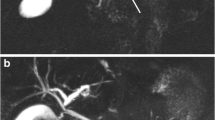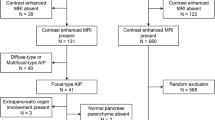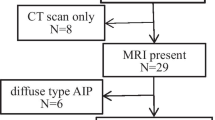Abstract
Objective
To determine reliable MRI features of autoimmune pancreatitis (AIP) in the proximal pancreas that could allow its differentiation from pancreatic ductal adenocarcinoma (PDAC).
Methods
Twenty-three patients with AIP and 61 patients with PDAC in the proximal pancreas underwent MRI. Two observers analyzed MRI for lesion morphology, hypointensity degree on T1-weighted images, enhancement pattern during dynamic phases, capsule-like rim, presence of cysts and duct penetrating sign, morphology of bile duct, and icicle appearance and tortuosity of the upstream pancreatic duct. Sensitivity and specificity for the diagnosis of AIP were calculated for each category or combined.
Results
When isointensity on the portal and late phase of MRI and/or the icicle sign of pancreatic duct are applied, 100 % sensitivity for the diagnosis of AIP in the proximal pancreas was achieved. Applying both mild T1 hypointensity similar to the spleen and the icicle sign enabled 100 % specificity for the diagnosis of AIP by differentiating it from PDAC.
Conclusion
The combination of the icicle sign in the upstream pancreatic duct and mild T1 hypointensity or isointensity on portal and late phase of dynamic MRI could be reliable MR features for the diagnosis of AIP in the proximal pancreas by allowing its differentiation from PDAC.
Key Points
• The icicle sign of the pancreatic duct is useful for diagnosing AIP.
• Mild T1 hypointensity similar to the spleen is useful for diagnosing AIP.
• Isointensity on portal and late phases MRI is useful for diagnosing AIP.





Similar content being viewed by others
Abbreviations
- AIP:
-
Autoimmune pancreatitis
- PDAC:
-
Pancreatic ductal adenocarcinoma
- MRI:
-
Magnetic resonance imaging
- MRCP:
-
MR cholangiopancreatography
- 2D:
-
2 dimensional
- 3D:
-
3 dimensional
- AP:
-
Arterial phase
- PVP:
-
Portal venous phase
- T1WI:
-
T1-weighted images
- T2WI:
-
T2-weighted image
- AUC:
-
Areas under the receiver operating characteristics curve
References
Finkelberg DL, Sahani D, Deshpande V, Brugge WR (2006) Autoimmune pancreatitis. N Engl J Med 355:2670–2676
Yoshida K, Toki F, Takeuchi T, Watanabe S, Shiratori K, Hayashi N (1995) Chronic pancreatitis caused by an autoimmune abnormality. Proposal of the concept of autoimmune pancreatitis. Dig Dis Sci 40:1561–1568
Kamisawa T, Egawa N, Nakajima H (2003) Autoimmune pancreatitis is a systemic autoimmune disease. Am J Gastroenterol 98:2811–2812
Stone JH, Zen Y, Deshpande V (2012) IgG4-related disease. N Engl J Med 366:539–551
Chari ST, Smyrk TC, Levy MJ et al (2006) Diagnosis of autoimmune pancreatitis: the Mayo Clinic experience. Clin Gastroenterol Hepatol 4:1010–1016, quiz 1934
Gardner TB, Levy MJ, Takahashi N, Smyrk TC, Chari ST (2009) Misdiagnosis of autoimmune pancreatitis: a caution to clinicians. Am J Gastroenterol 104:1620–1623
Hardacre JM, Iacobuzio-Donahue CA, Sohn TA et al (2003) Results of pancreaticoduodenectomy for lymphoplasmacytic sclerosing pancreatitis. Ann Surg 237:853–858, discussion 858-859
Sun GF, Zuo CJ, Shao CW, Wang JH, Zhang J (2013) Focal autoimmune pancreatitis: radiological characteristics help to distinguish from pancreatic cancer. World J Gastroenterol 19:3634–3641
Kim KP, Kim MH, Kim JC, Lee SS, Seo DW, Lee SK (2006) Diagnostic criteria for autoimmune chronic pancreatitis revisited. World J Gastroenterol 12:2487–2496
Okazaki K, Kawa S, Kamisawa T et al (2006) Clinical diagnostic criteria of autoimmune pancreatitis: revised proposal. J Gastroenterol 41:626–631
Otsuki M, Chung JB, Okazaki K et al (2008) Asian diagnostic criteria for autoimmune pancreatitis: consensus of the Japan-Korea Symposium on Autoimmune Pancreatitis. J Gastroenterol 43:403–408
Shimosegawa T, Chari ST, Frulloni L et al (2011) International consensus diagnostic criteria for autoimmune pancreatitis: guidelines of the International Association of Pancreatology. Pancreas 40:352–358
Choi EK, Kim MH, Kim JC et al (2006) The Japanese diagnostic criteria for autoimmune chronic pancreatitis: is it completely satisfactory? Pancreas 33:13–19
Shimosegawa T, Kanno A (2009) Autoimmune pancreatitis in Japan: overview and perspective. J Gastroenterol 44:503–517
Irie H, Honda H, Baba S et al (1998) Autoimmune pancreatitis: CT and MR characteristics. AJR Am J Roentgenol 170:1323–1327
Muhi A, Ichikawa T, Motosugi U et al (2012) Mass-forming autoimmune pancreatitis and pancreatic carcinoma: differential diagnosis on the basis of computed tomography and magnetic resonance cholangiopancreatography, and diffusion-weighted imaging findings. J Magn Reson Imaging 35:827–836
Hur BY, Lee JM, Lee JE et al (2012) Magnetic resonance imaging findings of the mass-forming type of autoimmune pancreatitis: comparison with pancreatic adenocarcinoma. J Magn Reson Imaging 36:188–197
Manfredi R, Frulloni L, Mantovani W, Bonatti M, Graziani R, Pozzi Mucelli R (2011) Autoimmune pancreatitis: pancreatic and extrapancreatic MR imaging-MR cholangiopancreatography findings at diagnosis, after steroid therapy, and at recurrence. Radiology 260:428–436
Wakabayashi T, Kawaura Y, Satomura Y et al (2003) Clinical and imaging features of autoimmune pancreatitis with focal pancreatic swelling or mass formation: comparison with so-called tumor-forming pancreatitis and pancreatic carcinoma. Am J Gastroenterol 98:2679–2687
Moon SH, Kim MH, Park DH et al (2008) Is a 2-week steroid trial after initial negative investigation for malignancy useful in differentiating autoimmune pancreatitis from pancreatic cancer? A prospective outcome study. Gut 57:1704–1712
Chandrasegaram MD, Chiam SC, Nguyen NQ et al (2013) A case of pancreatic cancer in the setting of autoimmune pancreatitis with nondiagnostic serum markers. Case Rep Surg 2013:809023
Kawaguchi K, Koike M, Tsuruta K, Okamoto A, Tabata I, Fujita N (1991) Lymphoplasmacytic sclerosing pancreatitis with cholangitis: a variant of primary sclerosing cholangitis extensively involving pancreas. Hum Pathol 22:387–395
Suda K, Takase M, Fukumura Y et al (2005) Histopathologic characteristics of autoimmune pancreatitis based on comparison with chronic pancreatitis. Pancreas 30:355–358
Zhang L, Notohara K, Levy MJ, Chari ST, Smyrk TC (2007) IgG4-positive plasma cell infiltration in the diagnosis of autoimmune pancreatitis. Mod Pathol 20:23–28
DeLong ER, DeLong DM, Clarke-Pearson DL (1988) Comparing the areas under two or more correlated receiver operating characteristic curves: a nonparametric approach. Biometrics 44:837–845
Choi YJ, Byun JH, Kim JY et al (2008) Diffuse pancreatic ductal adenocarcinoma: characteristic imaging features. Eur J Radiol 67:321–328
Bachem MG, Schünemann M, Ramadani M et al (2005) Pancreatic carcinoma cells Induce fibrosis by stimulating proliferation and matrix synthesis of stellate cells. Gastroenterology 128:907–921
Chari ST, Kloeppel G, Zhang L et al (2010) Histopathologic and clinical subtypes of autoimmune pancreatitis: the honolulu consensus document. Pancreatology 10:664–672
Manfredi R, Frulloni L, Mantovani W, Bonatti M, Graziani R, Pozzi Mucelli R (2011) Autoimmune pancreatitis: pancreatic and extrapancreatic MR imaging-MR cholangiopancreatography findings at diagnosis, after steroid therapy, and at recurrence. Radiology 260:428–436
Kitagami H, Kondo S, Hirano S, Kawakami H, Egawa S, Tanaka M (2007) Acinar cell carcinoma of the pancreas: clinical analysis of 115 patients from Pancreatic Cancer Registry of Japan Pancreas Society. Pancreas 35:42–46
Gangi S, Fletcher JG, Nathan MA et al (2004) Time interval between abnormalities seen on CT and the clinical diagnosis of pancreatic cancer: retrospective review of CT scans obtained before diagnosis. AJR Am J Roentgenol 182:897–903
Kamisawa T, Notohara K, Shimosegawa T (2010) Two clinicopathologic subtypes of autoimmune pancreatitis: LPSP and IDCP. Gastroenterology 139:22–25
Motosugi U, Ichikawa T, Morisaka H et al (2011) Detection of pancreatic carcinoma and liver metastases with gadoxetic acid-enhanced MR imaging: comparison with contrast-enhanced multi-detector row CT. Radiology 260:446–453
Acknowledgments
The guarantor of this study: Young Kon Kim M.D., Ph D. The authors of this manuscript declare no relationships with any companies whose products or services may be related to the subject matter of the article. The authors state that this work has not received any funding. Min Ji Kim, Ph D. of the statistics department in the Samsung Medical Centre kindly provided statistical advice for this manuscript. Institutional Review Board approval was obtained. Written informed consent was waived by the Institutional Review Board. Methodology: retrospective, case-control study, performed at one institution.
Author information
Authors and Affiliations
Corresponding author
Rights and permissions
About this article
Cite this article
Kim, H.J., Kim, Y.K., Jeong, W.K. et al. Pancreatic duct “Icicle sign” on MRI for distinguishing autoimmune pancreatitis from pancreatic ductal adenocarcinoma in the proximal pancreas. Eur Radiol 25, 1551–1560 (2015). https://doi.org/10.1007/s00330-014-3548-4
Received:
Revised:
Accepted:
Published:
Issue Date:
DOI: https://doi.org/10.1007/s00330-014-3548-4




